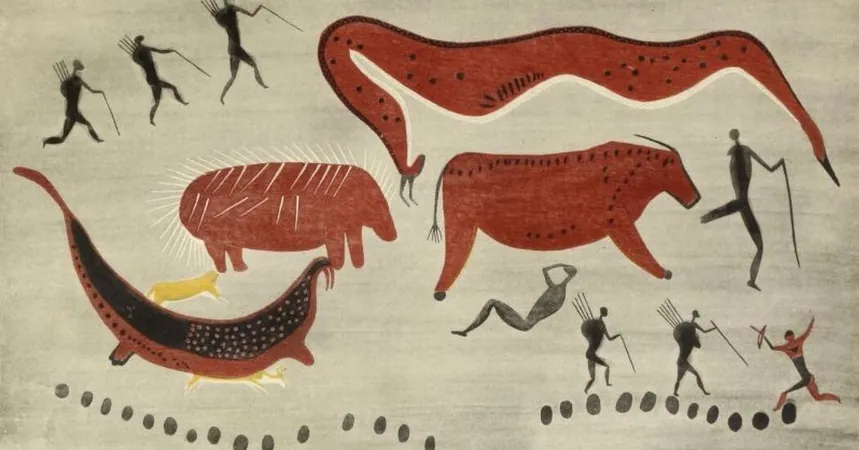
Unearthing History: How Ancient Fossils May Have Inspired Mysterious Rock Art in South Africa
2024-09-18
Author: Lok
Introduction
On a striking sandstone cliff in South Africa lies a captivating rock painting known as the Horned Serpent panel. This artwork depicts a fierce battle scene, complete with flying spears and shield-bearing warriors charging into a fray that features a variety of local wildlife, including an aardvark and numerous antelope. However, one creature depicted in this 200-year-old panel stands out—an odd, whimsical entity that combines features of a lizard and a walrus, adorned with polka dots.
The Study
A recent study published in the journal PLOS One argues that this peculiar creature may not just be a figment of artistic imagination but rather a representation influenced by ancient fossil finds from the region. Dr. Julien Benoit, a paleontologist at the University of the Witwatersrand in Johannesburg and author of the study, proposes that the San people, Indigenous to southern Africa, possessed significant paleontological knowledge that predates modern scientific understanding of extinct species.
Discovery and Fossil Evidence
Dr. Benoit became intrigued by the rock art after finding it referenced in an old book from 1930. An illustration of the tusked creature sparked his recognition of it as a possible representation of dicynodonts—large, herbivorous creatures that lived during the Triassic Period. These amazing animals possessed a beak resembling that of a turtle and two prominent tusks, making them distinctive in the prehistoric landscape before their extinction roughly 200 million years ago, long before any humans were around to witness them.
Exploration of the Rock Wall
In a quest to uncover more, Dr. Benoit located the original rock wall featuring the Horned Serpent panel in a central mountainous area of South Africa. His exploration turned up numerous fossil fragments, confirming that dicynodont remains are relatively plentiful in the region. Prior excavations have even uncovered more complete specimens, including skulls and well-preserved body parts, hinting at a rich fossil history.
Artistic Interpretation
Dr. Benoit theorizes that the San's depiction of the Horned Serpent was inspired by these fossil remains. Notably, the curved back of the creature in the painting resembles the "death pose" often seen in fossilized dicynodont skeletons. The dotted skin of this quirky creature could be a nod to the textured surfaces observed in fossil specimens. If validated, the Horned Serpent would represent the earliest known depiction of a dicynodont, predating the first Western descriptions of the species by at least a decade.
Support from Other Scholars
Adrienne Mayor, a science historian from Stanford University, supports this idea, noting the San's deep understanding of both living and extinct species. She points to other significant sites, like Mokhali Cave in Lesotho, where San artistry reflects an awareness of dinosaur footprints and birdlike creatures, showcasing a remarkable accuracy that surpasses earlier Western interpretations of such animals.
Conclusion
While Kenneth Angielczyk, a paleontologist from the Field Museum in Chicago, acknowledges the challenges in definitively classifying the Horned Serpent as a dicynodont, he agrees that local fossils almost certainly sparked the imagination of the San artists. The possibility that ancient peoples integrated such creatures into their worldview adds an exciting layer to our understanding of how early humans interacted with their environment.
As we delve deeper into our history, it becomes clear that the San people's art does more than capture their world; it intersects with the annals of paleontology in ways once thought impossible. The Horned Serpent panel stands as a mesmerizing testament to the timelessness of nature's wonders and the intelligence of those who came long before us. Could this be the key to unlocking even more evolutionary mysteries hidden in plain sight?



 Brasil (PT)
Brasil (PT)
 Canada (EN)
Canada (EN)
 Chile (ES)
Chile (ES)
 Česko (CS)
Česko (CS)
 대한민국 (KO)
대한민국 (KO)
 España (ES)
España (ES)
 France (FR)
France (FR)
 Hong Kong (EN)
Hong Kong (EN)
 Italia (IT)
Italia (IT)
 日本 (JA)
日本 (JA)
 Magyarország (HU)
Magyarország (HU)
 Norge (NO)
Norge (NO)
 Polska (PL)
Polska (PL)
 Schweiz (DE)
Schweiz (DE)
 Singapore (EN)
Singapore (EN)
 Sverige (SV)
Sverige (SV)
 Suomi (FI)
Suomi (FI)
 Türkiye (TR)
Türkiye (TR)
 الإمارات العربية المتحدة (AR)
الإمارات العربية المتحدة (AR)